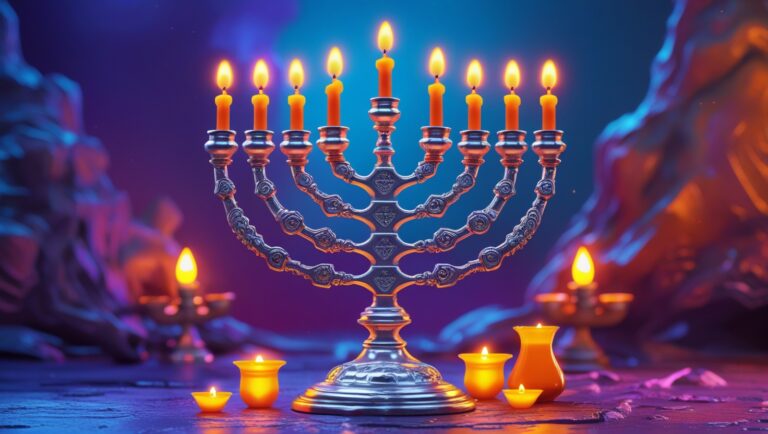At first glance, Tu B’Av and Yom Kippur seem worlds apart but here we will reveal a powerful connection between them
Tu B’Av, the “Festival of Love,” (some people call it Jewish Valentines) marks a joyous celebration in the Jewish calendar. Yom Kippur, on the other hand, is the solemn Day of Atonement (Kapara), a time of fasting, prayer, and Teshuva. Yet, beneath the surface, these two days share a deep spiritual connections that reflect the deeper truths of the human soul and its relationship with Hashem.
Love and Unity: The Essence of Both Days
Tu B’Av, celebrated on the 15th of Av and, according to the Talmud, it was a day when the unmarried women of Jerusalem would go out in white garments and dance in the vineyards, while men sought their soulmates. There are many deep secrets to the idea of Shidduch (“[finding one’s] mate”) but we won’t dive in them right now.
Either way, the day symbolizes unity, love, and the breaking down of societal barriers, as marriages often crossed family and tribal lines. Those were simpler times when apparently we didn’t have Shadchanim (“matchmakers”), or at least it was unheard of.
Yom Kippur, while centered on atonement and forgiveness, also contains an element of unity. On this day, the entire Jewish community comes together in collective repentance “k’ish echad b’lev echad” (as one man with one heart). The essence of Yom Kippur is about reconnecting with one’s higher self and with God, which ultimately fosters a deeper sense of unity among the Jewish people. In fact, the Mishnah in Taanit (4:8) teaches that both Tu B’Av and Yom Kippur were the most joyous days for the Jewish people, hinting at an intrinsic connection between these two seemingly opposite days.
Here’s a list of the joyous events that occurred on Tu B’Av, along with some Kabbalistic explanations that offer deeper insights into the significance of this special day:
1. The Lifting of the Ban on Inter-Tribal Marriage
- Event: After the conquest of the Land of Israel, an initial decree was made that prevented women who inherited land from marrying outside of their tribe. This ensured that land would remain within the tribe’s inheritance via the man (who inherits the woman). On Tu B’Av, this restriction was lifted, allowing for greater unity and connection among the tribes of Israel.
- Kabbalistic Explanation: This symbolizes the unification of all the soul roots of Israel. In Kabbalah, each tribe represents a different aspect of the divine light through one of the 12 anagrams of the YHVH ineffable name. The lifting of the ban allowed for the merging of these lights, creating harmony and completeness within the collective soul of Israel, reflecting the higher unity of the Sephirot when they work together. When we are together (in Torah), we really win.
2. The Reconciliation of the Tribes with the Tribe of Binhamin
- Event: Following the civil war between the Tribe of Benjamin and the other tribes of Israel (as described in Judges 19-21), the tribe of Benjamin was ostracized. On Tu B’Av, the tribes reconciled, allowing the Tribe of Benjamin to reenter the community and intermarry with the other tribes. It’s shocking to see that only 600 men remained, but they were helped later on so that one of the tribes wouldn’t be exterminated.
- Kabbalistic Explanation: The Tribe of Benjamin, associated with the Sefirah of Malkhut (foundation), plays a crucial role in channeling divine energy into the world. The reconciliation symbolizes the repair of the connection between the lower worlds and the divine source, healing a major breach in the spiritual pipelines.
3. The Cessation of the Generation of the Wilderness’ Deaths
- Event: After the sin of the spies, the Hebrews were condemned to wander in the desert for 40 years, during which a portion of them died each year on Tisha B’Av. Every year the men would dig up graves before Tisha B’Av for themselves to lie there in case they were destined to die that year. On the last year in the wilderness, they dug up the graves but no one died. Thinking they miscalculated the day, they continued to live there until Tu B’Av, when they realized the decree ended, and no more Israelites perished due to the sin.
- Kabbalistic Explanation: This signifies the restoration of the divine favor to the generation of the wilderness. Kabbalistically, it represents the lifting of the judgments (Gevurot) and the return of Chesed (kindness) to the people. It also reflects the completion of a tikkun (rectification) for the sin of the spies, allowing for a higher level of divine consciousness to reenter the people of Israel.
4. The Removal of the Blockade Preventing Pilgrimage to Jerusalem
- Event: After the division of the Kingdom of Israel, King Yeroboam set up roadblocks to prevent the Israelites from the Northern Kingdom from traveling to Jerusalem for pilgrimage festivals. On Tu B’Av, these barriers were removed, allowing the people to return to Jerusalem to serve God at the Holy Temple.
- Kabbalistic Explanation: The restoration of access to Jerusalem reflects the reunification of Malchut (the earthly kingdom) with its divine source in Atzilut. It symbolizes the return of divine light to the Shekhinah, the feminine aspect of God, and the reconnection of the lower worlds to the upper worlds connected via the Holy Temple. The ability to once again ascend to Jerusalem mirrors the soul’s ability to ascend to higher spiritual levels.
5. The Roman Permission to Bury the Victims of Betar
- Event: After the Bar Kochba revolt, the Romans massacred the inhabitants of Betar. For a time, the Romans prohibited the burial of the dead. On Tu B’Av, permission was finally granted for their burial.
- Kabbalistic Explanation: In Kabbalah, burial is associated with the process of rectification and the return of the physical body to its source. The burial of the dead of Betar signifies a tikkun for the souls of the fallen and the completion of their earthly journey since the soul cannot rest until the body is properly buried and desintegrates. It also symbolizes the elevation of the sparks of holiness that were trapped within the physical world, allowing them to ascend back to their divine source in the spiritual worlds above.
6. The Day of the Cutting of the Wood for the Altar
- Event: On Tu B’Av, the woodcutters completed their work of cutting wood for the Temple altar, ensuring that the fire on the altar would never go out. This was considered a joyous occasion, as it represented the continued functioning of the sacrificial service.
- Kabbalistic Explanation: The wood represents the raw material of the physical world, and its placement on the altar symbolizes the transformation of the material into the spiritual through holy service. In Kabbalah, fire represents the passion and love of the soul for Hashem. The continual burning of the wood on the altar signifies the soul’s perpetual yearning and ascent toward divine union.
7. Tu B’Av as a Day for Finding a Soulmate
- Event: As we mentioned above, Tu B’Av is traditionally known as a day when unmarried women would dress in white and go out into the vineyards to meet their soulmates. This is seen as a day particularly auspicious for matchmaking and marriage.
- Kabbalistic Explanation: Marriage in Kabbalah is the ultimate symbol of the union between the masculine and feminine aspects of the divine—Zer Anpin (the small face) and Malchut (the kingdom). The finding of a soulmate on Tu B’Av reflects the cosmic harmony and balance achieved when these Partzufim are united. On a personal level, it also symbolizes the soul’s reunion with its other half, bringing it closer to its ultimate purpose and fulfillment in life.
The Theme of Forgiveness
There’s yet another connection between Tu B’Av and Yom Kippur lies in the theme of forgiveness. Yom Kippur is the culmination of a period of self-reflection, where we ask for and grant forgiveness for wrongs committed throughout the year. It is a time for cleansing the soul and repairing damaged relationships with both God and others.
While many people like to interpret that the term HaKippur[im] literally means “like Purim” to mean that it’s on an inferior level than it, the truth is each of the Chaguim have its own aspect in which it is above the others (and rectifies a different Sephira of Adam Kadmon). Yom HaKippurim though is on a higher level than all others in that the Partzufim rise to the “Nekudor”, the most-general spiritual system, ever available with its unique 5 tefilot (Arvit, Shacharit, Mussaf, Mincha and Neilah).
The marriage theme of Tu B’Av however reflects the highest possible elevation for men and women, which parallels all the service we do on Yom Kipur.
White Garments: Symbol of Purity
Both Tu B’Av and Yom Kippur share the symbolism of white garments. On Tu B’Av, the unmarried women would dress in white, symbolizing purity and equality. Men also wear white garments on Yom Kippur, known as kittel, also symbolize purity, as they evoke the image of Malakhim (angels) and the soul’s potential to transcend the physical world and return to a state of innocence.
The white garments remind us of the soul’s pure essence, untainted by sin or imperfection, an idea that is central to both Yom Kippur’s atonement process and Tu B’Av’s celebration of love and new beginnings.
The Connection to Hashem
Both Tu B’Av and Yom Kippur share a mystical aspect in their connection to Hashem. On Yom Kippur, we ascend to a state of near-angelic existence, fasting and refraining from physical pleasures in order to draw closer to God. The prayers of Yom Kippur, especially Neilah, reflect this yearning for closeness and forgiveness as we reach the highest level attainable for the first seal of the year (the second is in Hoshanah Rabba).
Tu B’Av, too, is a day of heightened spiritual connection. The love celebrated on this day is not just romantic love, but an expression of divine love. The Kabbalists explain that the love between two people reflects the divine love between God and Israel. Tu B’Av marks the full moon of the month of Av, symbolizing completeness and the illumination of the hidden divine light that shines in the world through acts of unity and love.
A Cycle of Renewal
Ultimately, both Tu B’Av and Yom Kippur embody the cycle of renewal. Tu B’Av celebrates the renewal of life and love, the blossoming of new relationships, and the mending of old ones. It’s a semi-chag where most people get together to eat nowadays, but still reflects this theme. Yom Kippur represents spiritual renewal, a time to reset and purify the soul for the year ahead.
These two days serve as powerful reminders of the cyclical nature of life—of death and rebirth, sin and forgiveness, separation and unity. Together, Tu B’Av and Yom Kippur offer a holistic spiritual journey: one that celebrates love and unity in the physical world, while also guiding us toward divine connection and spiritual purity.







